So you’ve been hearing all the buzz about “value ladders” and wondering whether you need one? Or how to set one up? Well, you’re in the right place my friend, we’re going to walk you through all of that and more! But first, a definition:
What is a value ladder? A value ladder is a lineup of offers that increase in price and value in order to meet people where they are on their journey to become a customer: from initial awareness to their final decision to buy your premium offerings. It’s an effective way for you to build trust and maximize the lifetime value of each customer.
The way it works in a nutshell: you start off by offering something of value for free and then increase the price and value with your subsequent offers.
They’re usually discussed in the context of sales funnels and it can sometimes sound like: “get as much money out of ’em as possible for as long as you can!”
But a business’s first imperative is to get and keep customers, and when you do that, the revenue will follow. So when you’re planning your value, be sure to make your customer’s experience the primary focus.
A value ladder, when executed correctly, is actually interlinked with your brand strategy. Your lineup of offers is used to build trust and ultimately, inspire brand loyalty. In other words…
You use a value ladder to get and keep customers
Before we get into the details about how to create a value ladder, let’s first take a look at how this all works from the perspective of your customer.
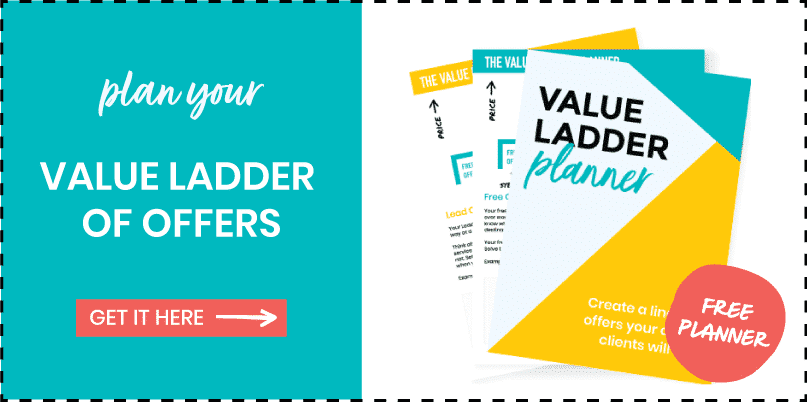
Why You Need A Value Ladder
It’s easy to forget that most of your customers who see your marketing messages aren’t going to sign up instantly. There’s no magical formula that can persuade someone to whip out their credit card and purchase a premium offering if they’re just not ready.
Enter… the value ladder.
It’s a way to meet people where they are in their decision-making process and readiness to commit to a purchase. So let’s talk about what that looks like…
Your customer’s decision-making process to make a purchase
The goal of your brand strategy should be to communicate the reasons why customers should choose you instead of all their other options.
Along the way, your job is to provide value and earn their trust in order to help them make that decision.
(Also known as marketing.)
From your customer’s perspective, the journey looks like this…
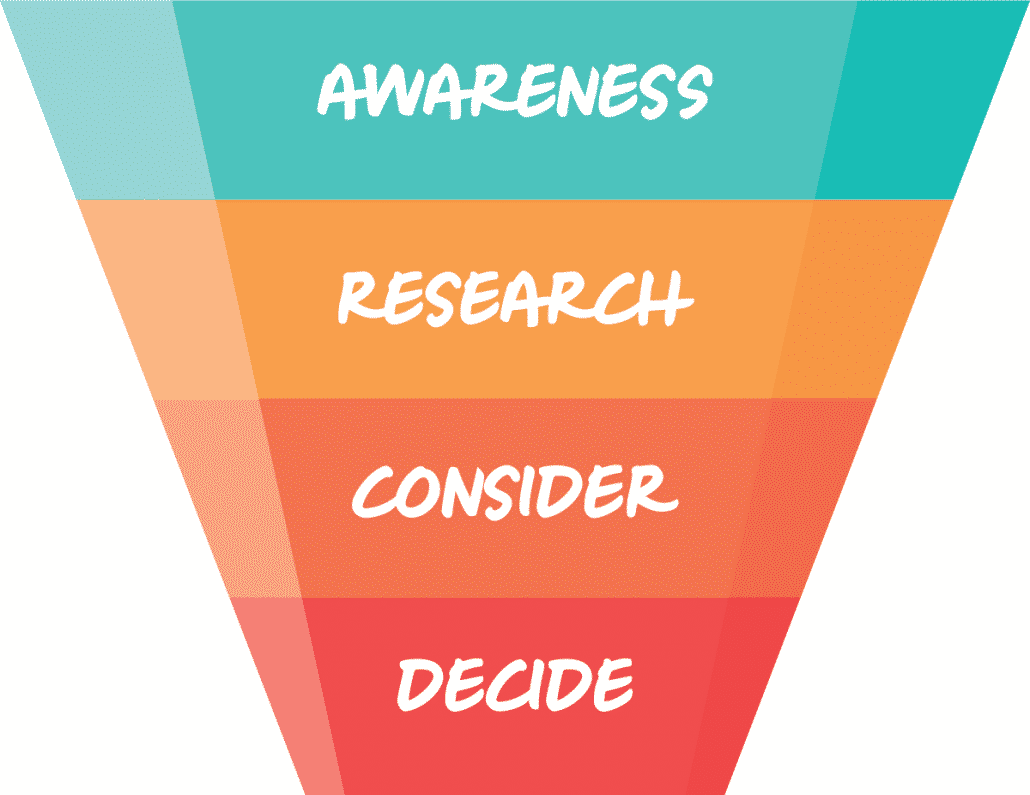
When businesses forget that potential clients are going through this process, they do things like drop a bulleted list of capabilities on their services page with a “get a quote” button and call it good.
Which, for all of the people who are just beginning to become aware that they maybe-possibly need help, sounds like this:
“MAKE A DECISION NOW! DO YOU WANT TO HIRE ME? YES OR NO!!!”
Kind of awkward on a first encounter, right?
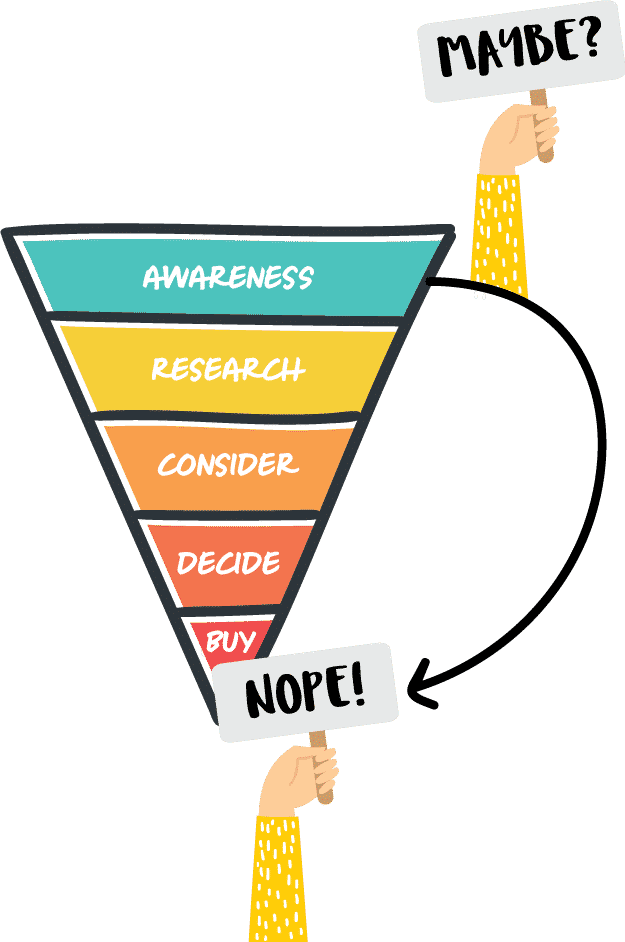
A value ladder, in contrast, takes prospective clients by the hand from the very first interaction and walks side by side with them as they grow to trust you.
A value ladder guides your clients toward purchasing your premium offers by providing them with smaller offers along the way
Visually, then, it looks something like this…
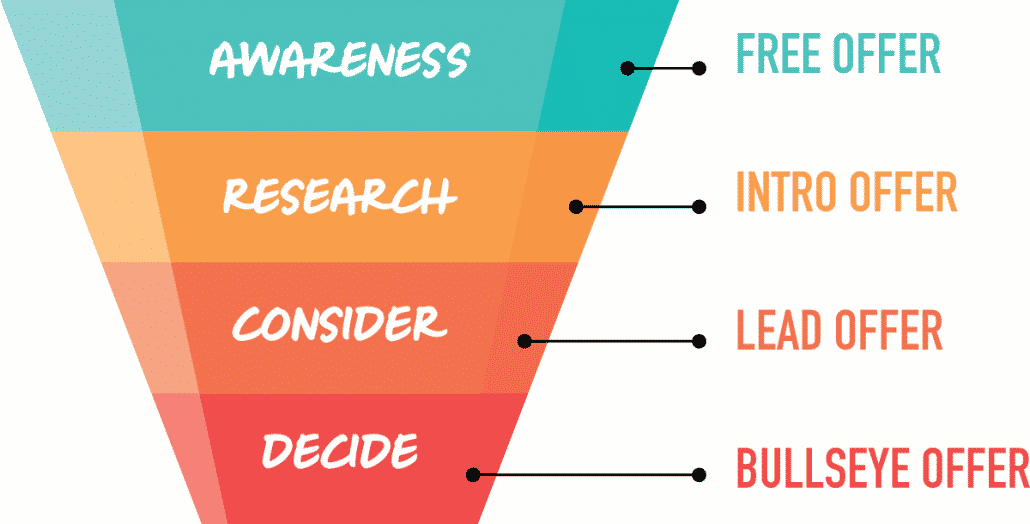
Now, their journey and your offers aren’t always going to line up perfectly like this. For example, people in the consideration phase may sign up for a free offer. But here’s the key takeaway:
Having different offers at various price points means there’s something for everyone.
A little sneak preview for ya here (I’ll get into more detail when we talk about how to create a value ladder), but what we’re essentially going to do now is take the idea of creating different offers as part of the customer journey, and then rotate the customer journey funnel onto its side. And voila! Now it looks like a ladder.
Neat, right? 🙂
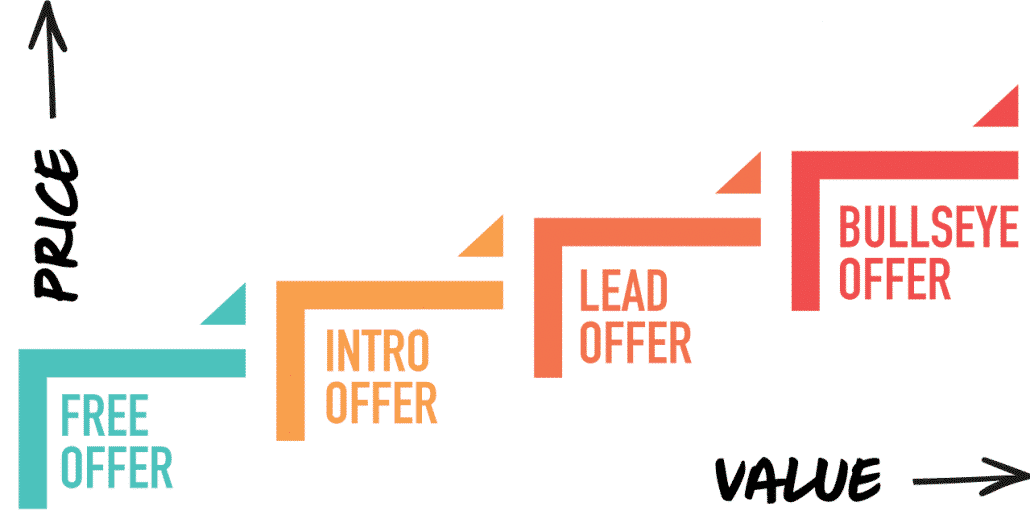
The ladder is a great metaphor because as you can see, now we can visualize how we’re going to create offers that will increase in price and value and naturally lead from offer one to the next.

The Benefits of a Value Ladder
A value ladder focuses on solving a problem your client is grappling with and gives them options to solve that problem based on their readiness to commit and their budget.
Because you’re the expert, you’ll design service offerings that give them the outcome they desire.
This approach is very different than reacting to a potential client who rolls up and tells you what they think they need and asks you for a quote. They’re not steering the ship here, you are, which is why figuring out what to include in your offers takes a bit of upfront work.
But the advantage is that for you, there’s no recreating the wheel figuring out what each and every potential client wants and preparing time-costly proposals–instead, you’ll be identifying the problem(s) in advance and have solutions to offer them all ready-to-go.
Because it’s your process, and because you’re presenting it like a product (you’re selling whatever is needed for them to get that outcome), you’ll be perceived as the go-to expert rather than an order-taker. And when you do that, it’s easier for people to understand. They’ll come to you to follow your process because you’re offering the outcome they want. Make sense?
Have The Flexibility to Upsell and Downsell Your Offerings
Once you have the steps of your ladder in place, you’ll upsell along the way.
For example, when people buy your low-priced INTRO offer (also known as a tripwire), you can pitch your LEAD offer as a next step. Then, you can present your BULLSEYE premium offer and so on.
You can also experiment with the order!
For example, you might offer something for free — let’s say a webinar — and then pitch them on your highest-ticket offering.
For those customers who don’t buy your high-ticket offer, you can “downsell” by offering them an INTRO or LEAD offer instead. (Which can be set on autopilot with automated follow-up email sequences.)
By having different offerings at varying degrees of value, you’ll have something to offer people based on what they need and how much they’re willing to spend.
Earn The Trust of Hesitant Customers
A tripwire or low-cost offer helped me win clients who were interested in my premium 1-1 services.
I found that 10% of the people who purchased a low-price offer (a $30 eBook) went on to sign up for thousands of dollars in services. In those cases, they were interested in hiring me (closer to the “decision” phase), but they wanted some final reassurance that if they trusted me with their dollars, I’d deliver value.
So they grabbed one of my low-priced offers to “vet” me. Interesting, right?
Here’s where it gets even more interesting…
The price of that product was $30.
When I calculate the lifetime value of a customer who does 1-1 work with me, it works out to about $3,600 per customer. (Some are a few hundred bucks one-and-done and some are tens of thousands over years.)
So for a small investment in my time to create a simple eBook, I’m able to shortcut the time and effort it normally takes to earn the trust of a complete internet stranger and potentially for life. Which is far more than $30, it’s more than 100 times that! (Results will vary of course, but I did want you to see the big picture.)
Not only that…
A Value Ladder Extends The Lifetime Value of a Customer
Because you’re incorporating different offerings into your lineup, you have the potential to extend that lifetime value.
An introductory or low-price offer (which should be a digital product of some kind) can actually be quite profitable and generate an evergreen passive income stream.
A lead service (which I’ll get to in a sec) can help you recapture all the time that slips through the cracks pitching your services to people who are just kicking tires and are never going to get there.
The way I like to think of these initial steps in your ladder is they’re a way to monetize your sales and marketing and leverage your time (so you have more of it to fine-tune your processes and make passive income products!)
You can also extend your premium services by creating “loyalty” offers!
Hopefully, by now you’re chomping at the bit to get started, so let’s get into it…
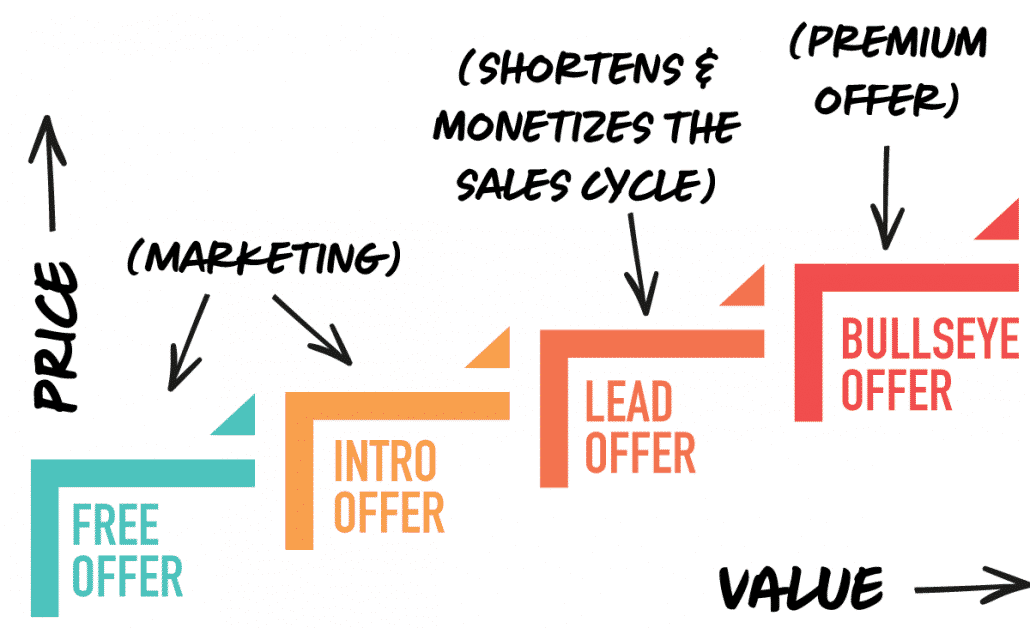
How to Create a Value Ladder
There are many ways to go about it, but here’s a formula you can use to create a basic value ladder. Some value ladders have three steps and some have eight, it really all depends on what you’re offering.
If you offer more than one service line–for example, say you offer web design services and social media management, you would create a separate value ladder for each.
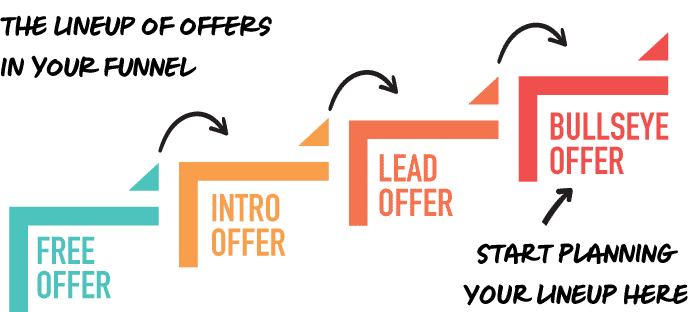
Step #1 Free Offer
Definition: The purpose of the free offer is to generate sales leads. Once you’ve identified your ideal client’s problems, you’ll demonstrate your expertise (you’re the one to solve it) by helping them solve their problem (5-10% of the way) with a free offer.
Ground rules: It has to be valuable. Your free offer is going to take the place of you getting on a sales call with them to demonstrate you’re trustworthy and an expert at solving this problem. Just because it’s free doesn’t mean it shouldn’t be valuable, quite the opposite.
Examples: Blog posts, a free e-book, checklists, swipe files, worksheets, how-to videos, audio exercises, a free introductory course, a webinar, etc.
This is how you’re going to get people to your website, but keep in mind that as people are going through their decision-making process and figuring out whether you’re the one to trust, it may take interacting with your brand 10-15 times or more before they’re ready to commit.
Having free content as an incentive to interact with you isn’t a magic sales bullet, it’s used to build trust. Make it valuable and focus on solving their problems, and when they’re ready to commit with dollars, you’ll be the one they turn to…
This is called reciprocity.
The idea is that when you’re providing value for free, your audience will begin to feel grateful for your help and even indebted to you. When deciding who to choose, they’ll be much more likely to go with you because you’ve already helped them solve their problem part of the way for free.
Step #2 Intro Offer
Definition: An intro offer is a low-priced offering that solves the problem a little bit more than your free offering
Ground rules: Again, it must be valuable. You’re still nurturing trust and establishing yourself as the go-to expert. Make sure it solves a specific problem and you’ve clearly articulated the outcome they can expect when they purchase it. The price should be set somewhere between $7-$49. Important: it should not require your time working 1-1 with clients.
Examples: eBook, paid workshop/webinar, an email challenge, a mini-course
Your intro offer isn’t designed to make a profit, but rather, to offset the costs of creating it and promoting it. The goal is to create a customer as quickly as possible so you can lead them to the next step, which is…
To learn more, we have an entire blog post devoted to setting up an intro offer (or tripwire) right here.
Step #3 Lead Offer
Definition: Your lead offer requires a larger financial commitment but it includes a much greater value. Here, you can begin offering 1-1 services that require your time, or, if you’re selling digital products, it will be a higher-priced offering than your tripwire but still less than your high-ticket offerings. This offer should be designed to be profitable.
Ground rules: Focus your lead offer on a specific outcome or “quick win” you can give your clients.
It must solve a problem and not create one. For example, if you’re designing a 1-1 service, an “audit” creates problems (“here are all the things you need to fix, have fun!”) whereas a road mapping or strategy session solves one (“here are your biggest opportunities and next steps”).
You should strive to create a service that allows you to replicate the process you’ll guide your clients through (no re-creating the wheel). This way, you can become better (more expert at solving this problem) and more efficient (and more profitable) the more you do it.
Things to consider:
- What aspects of your process are you currently doing for free that you can monetize instead?
- Is there an aspect of your larger high-ticket services you can “break apart” as a first step?
Examples: Road-mapping session, a done-for-you playbook or strategy, an introductory course, 1-1 coaching/consulting to achieve a specific result
Step #4 Bullseye Offer
Definition: A bullseye offer (or a “core offer”) is something we go into more detail about in The Bullseye Offer Formula, but basically this is where you pull out all the stops and do whatever you need to do to solve your customer’s biggest problem.
Ground rules: It should be priced based on the value of the outcome and really, the sky’s the limit. It’s your process and ideally, should utilize your zone of genius, the expertise you want to become known for. It must also be something your dream clients already know they need.
Examples: This is a high-priced offer–either a more comprehensive course or done-for-you 1-1 services.
Guiding people to a bullseye offer is where most people call it good, but to maximize the lifetime value of a customer, you can also create a…
BONUS (Step #5): Loyalty Offer
Definition: A loyalty offer extends the value of your signature offer by offering ongoing or ancillary services and digital products that continue to help them solve their problems.
Ground rules: Your loyalty offer provides you with ongoing revenue and allows you to create an ongoing relationship with your customers. These may be priced lower than your signature offer, but extends value over time.
Examples: Ongoing done-for-you services, a mastermind group, weekly group coaching calls, private paid Facebook group or slack channel, a membership site, subscription-based content, additional digital products, and courses to help them continue on their problem-solving journey, annual workshops or retreats.

Variations to Your Value Ladder
Again, the above is just an example to get you thinking about offering value along your customer’s journey. Every business is different and you may find that creating three steps is enough: maybe a freebie offer, an introductory offer, and a premium or signature service offering.
Maybe you’ll want six or seven steps in your ladder. You might decide to create two or three signature offers and a value ladder for each. Maybe you won’t have a signature service at all, maybe it makes more sense for you to create multiple introductory offers and then get people right into a loyalty offer.
Inside our course, we walk our students through the four key steps of the value ladder as a starting point, starting with the Bullseye Offer. Once you know where you’re leading people to, it becomes a “no-brainer” to create a logical, related line-up of offers that lead people to your premium 1-1 services.
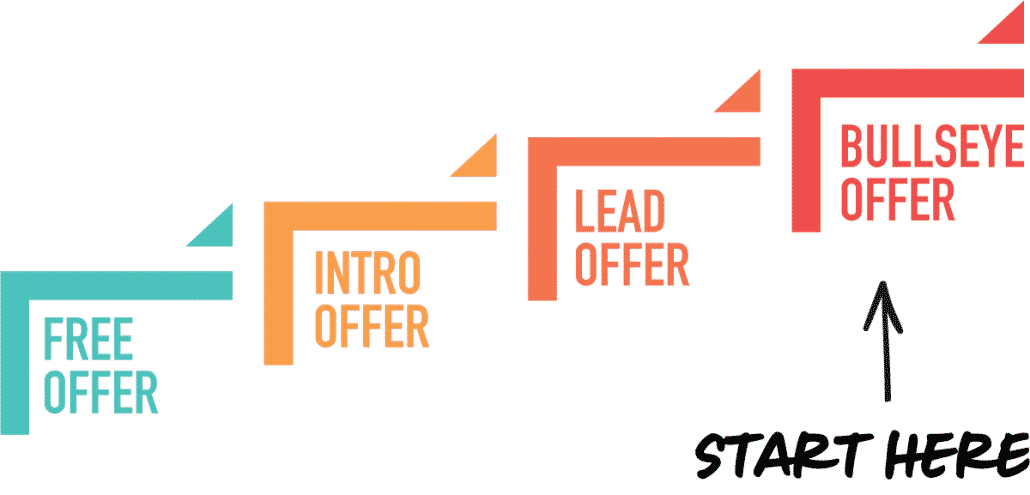
In summary
A value ladder helps make marketing your services easier. It allows you to earn trust, scale your business by increasing the lifetime value of a customer, and move away from selling your services like a commodity.
A commodity has no differentiated qualities; a brand is the opposite of a commodity and focuses on the value you can provide your customer. So in a way, the value ladder is just a framework for you to build your brand.
By creating different degrees of value-based offers corresponding where your customers are at in the decision-making process, you’re not only better positioned to get and keep clients but to maximize profit and lifetime customer value as well.
If you have any questions, hit us up in the comments and be sure to grab our FREE value ladder planner below!



An excellent post, most helpful. thank you! It has giving me food for thought and cleared up my initial confusion on how to apply this for a service based business. Cheers